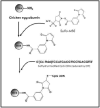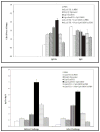Innovative strategies for co-delivering antigens and CpG oligonucleotides
- PMID: 19272328
- PMCID: PMC2656598
- DOI: 10.1016/j.addr.2008.12.013
Innovative strategies for co-delivering antigens and CpG oligonucleotides
Abstract
Cytosine-phosphorothioate-guanine oligodeoxynucleotides (CpG ODN) is a recent class of immunostimulatory adjuvants that includes unmethylated CpG dinucleotide sequences similar to those commonly found in bacterial DNA. CpG ODN specifically triggers toll like receptor 9 (TLR9), which is found within phagoendosomes of antigen presenting cells (APCs) such as dendritic cells (DCs). CpG ODN triggers activation and maturation of DCs and helps to increase expression of antigens. CpG ODN can be used to induce polarized Th1 type immune responses. Several studies have shown that antigens and CpG ODN must be co-localized in the same APC to generate the most potent therapeutic antigen-specific immune responses. Delivery vehicles can be utilized to ensure co-delivery of antigens and CpG ODN to the same APCs and to significantly increase uptake by APCs. These strategies can result in antigen-specific immune responses that are 5 to 500-fold greater than administration of antigen alone. In this review, we discuss several recent and innovative strategies to co-delivering antigens and CpG ODN adjuvants to APCs. These approaches include the utilization of conjugate molecules, multi-component nanorods, liposomes, biodegradable microparticles, pulsatile release chips and cell-microparticle hybrids.
Figures
















References
-
- Salem AK, Hung CF, Kim TW, Wu TC, Searson PC, Leong KW. Multi-component nanorods for vaccination applications. Nanotechnology. 2005;16(4):484–487.
-
- Sandler AD, Chihara H, Kobayashi G, Zhu XY, Miller MA, Scott DL, Krieg AM. CpG oligonucleotides enhance the tumor antigen-specific immune response of a granulocyte macrophage colony-stimulating factor-based vaccine strategy in neuroblastoma. Cancer Research. 2003;63(2):394–399. - PubMed
-
- Weiner GJ, Liu HM, Wooldridge JE, Dahle CE, Krieg AM. Immunostimulatory oligodeoxynucleotides containing the CpG motif are effective as immune adjuvants in tumor antigen immunization. Proceedings of the National Academy of Sciences of the United States of America. 1997;94(20):10833–10837. - PMC - PubMed
-
- Raychaudhuri S, Rock KL. Fully mobilizing host defense: Building better vaccines. Nature Biotechnology. 1998;16(11):1025–1031. - PubMed
-
- Mutwiri GK, Nichani AK, Babiuk S, Babiuk LA. Strategies for enhancing the immunostimulatory effects of CpG oligodeoxynucleotides. Journal of Controlled Release. 2004;97(1):1–17. - PubMed
Publication types
MeSH terms
Substances
Grants and funding
LinkOut - more resources
Full Text Sources
Other Literature Sources
Miscellaneous

